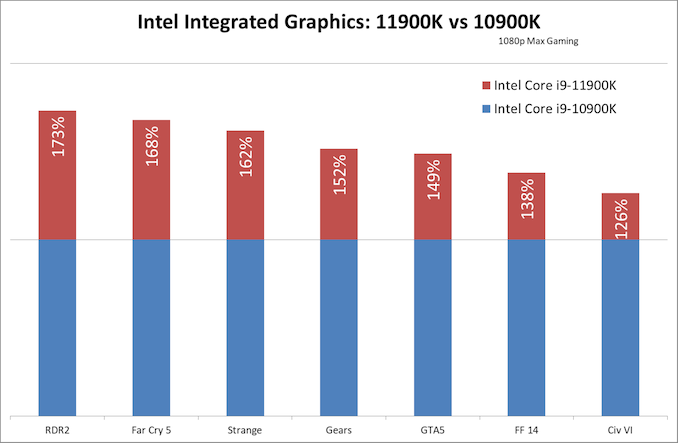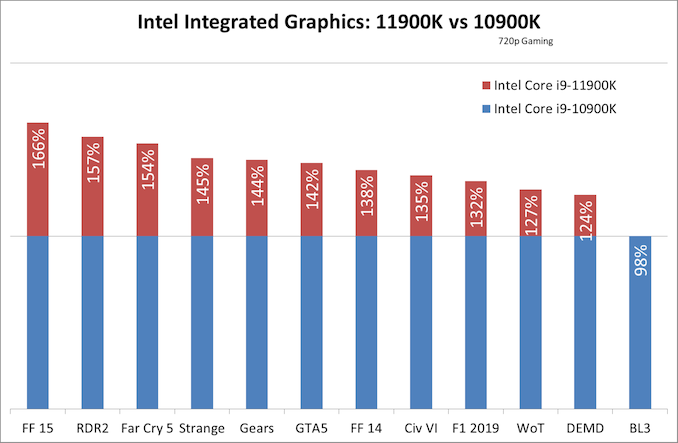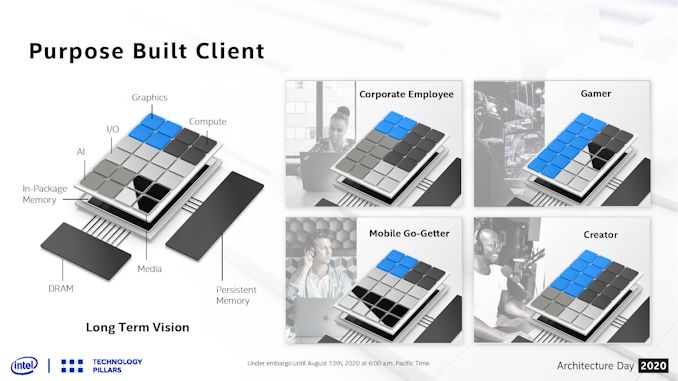Intel’s Integrated Graphics Mini-Review: Is Rocket Lake Core 11th Gen Competitive?
by Dr. Ian Cutress on May 7, 2021 10:20 AM ESTConclusions
No-one ever said that integrated graphics solutions had to be good. Nonetheless there is always the desire for something better, something higher performance, and something suitable for end-users. At the beginning of the era of integrated graphics, the focus was on simply providing something basic for 2D work - applications on an operating system and no real graphics rendering to mention. That solution is simple enough, however the demand on integrated graphics has grown over time, especially as the demands we put on our devices have also grown.
A modern system, especially a commercial system or one designed for work, has to do it all. Anyone not working in graphics might depend on a integrated solution to navigate complex arty web interfaces for the tool they use, or rely upon the acceleration features now baked into those platforms. Also perhaps, from time to time, some mild gaming use as well, if not outright using the compute features of the graphics for transcoding or AI. These demands are most heavily focused on mobile platforms, and as a result mobile platforms from Intel tend to get the best integrated graphics solutions, especially in thin-and-light designs where a discrete graphics solution is too power hungry. Intel's mobile Tiger Lake-U series offers a sizeable 96 execution units of the latest generation graphics architecture, compared to the desktop processors we are testing today, that only have 32.
So what use is a desktop processor with integrated graphics?
AMD and Intel both have product lines with integrated graphics. From Intel, its integrated graphics is in almost everything that Intel sells for consumers. AMD used to be that way in the mid-2010s, until it launched Ryzen, and now we have separate CPU-only and CPU+Graphics options. This is where the company philosophy differs.
AMD's desktop processors with integrated graphics are primarily intended to be a whole system replacement, with users relying on the integrated graphics for all their graphics needs. As a result AMD puts a lot more processing hardware into its integrated graphics solutions for the desktop, and it results in a good gaming experience for entry level gaming.
Intel's route on the otherhand is a bit more basic. The desktop integrated graphics here has two main directions: first, as the basic graphics needed for an office system, or second, more of a fall-back option for when the discrete card doesn't work or fails in more premium desktop systems. The power isn't there for hardcore grunt like gaming of any serious note, but it is certainly enough to cover the basics.
Despite this, with the new Xe-LP graphics solution, Intel has some aces up its sleeve. First is AV1 decoding, which allows users to watch AV1 content without putting stress on the CPU. Second is video encoding accelerationt through QuickSync, which has actually been a part of Intel's graphics for a number of years. Third is a relatively new feature: Intel's 'additional processor' mentality. Normally when a system has a discrete graphics card, the integrated graphics is disabled. But now, with its latest mobile devices for example, when Intel pairs its mobile processor with integrated graphics with a second graphics solution at about the same performance, with the right software Intel allows both graphics to work asynchrouusly on two different problems. The limit to this in the past has been dictating which graphics is the video out rather than simply a compute accelerator, but Intel believes it has worked it out. However, this is relatively little use for gaming, the topic of today.
Results Summary
In this review, we highlighted that Intel has now implemented its new Xe-LP graphics architecture onto its desktop processor line, and tested the new solutions against our traditional CPU gaming test suite. What we saw, in terms of a generational uplift from the i9-10900K to the i9-11900K, is actually quite impressive:
In our 720p testing, there's a clear generational gain across the board for Rocket Lake, and in most cases the games become a lot more playable. The average gain is 39%. If we flip to our gaming results at the higher resolution and settings:

Games with under 10 FPS across the board are left out
For these titles, the average gain is 153%, showing that Xe-LP is certainly a step up regardless of the workload.
The Future of Integrated Graphics
A key talking point about integrated graphics is whether a company should leverage a strong CPU product at the expense of graphics, or aim for something with strong integrated graphics as a more complete chip at the expense of the mid-range graphics market. The console market for example relies fully on integrated graphics designs, especially as it keeps the manufacturing simpler and number of chips lower. But on the desktop space, because discrete graphics are an option (well, when we're not in a mining craze or semiconductor shortage), there seems to be no impetus for companies to do a full fat integrated graphics solution that competes on the same stage as a mid-range graphics card. AMD could do it, but it might overlap with their console agreements, and Intel hasn't done anything serious since Broadwell.
To put a nod to Broadwell, Intel's 5th Gen processor. It was so powerful at integrated graphics at the time, we are still using it today as a comparison point when comparing against other Intel solutions. Broadwell had dedicated 48% of the die area of its top processor to graphics, and for that product it also added some really fast cache memory as well. Intel's focus on integrated graphics as a function of die size has decreased over time, now with Rocket Lake sits at around 20% of the silicon. It hasn't been this low since Intel first introduced its integrated graphics solutions. For that 20%, we get 32 execution units with eight processing cores. Tiger Lake has 96 EUs which total around 33% of overall die size, but has four cores. If Intel was focused on graphics performance in the same way as it was in Broadwell, we might be looking at a 256+ EU solution.
With Intel taking a renewed approach to graphics with its Xe portfolio, stemming from entry up to high performance compute, there is room here for Intel to develop integrated graphics focused solutions. Intel has detailed that it is moving to chiplets with its future mainstream processors under its 'Client 2.0' strategy, and part of that is allowing customers to select how many IP blocks they want of cores, IO, memory, security, and graphics. In the image above, the Gamer option has half of the die area for graphics. This could at the end of the day be a target that could see Intel making desktop integrated graphics a focus again.












165 Comments
View All Comments
Linustechtips12#6900xt - Saturday, May 8, 2021 - link
Do you realize they have pre-made orders from Sony/Microsoft they have to fufil???, and any silicon that goes to anything is great they are selling everthing they have they can't make enough of ANYTHING! more tsmc but still!, I understand you're want to build a pc right now but your going to have to wait, if you want to play games either buy a pre-built and get a 3000 series gpu or buy a console from scalpers either one is a decent option tho I would tend to go the way of prebuilts as funding the fucktardistans of scalpers is not a great idea.Qasar - Saturday, May 8, 2021 - link
Linustechtips12#6900xt, ignore the jian,the only thing he does on here, is find ways to bash amd in one way or another. most of what he posts, are just rants, no facts, just FUD.mode_13h - Sunday, May 9, 2021 - link
> Stop making console socs AMD so you'll have more wafers for stuff that makes NET INCOME.I'm not convinced they're actually buying these wafers, rather than Sony and MS. Even if they are, I'm sure they're contractually obligated by Sony and MS and don't have the option to simply divert console-designated wafers to be used for other AMD products.
I don't understand why people keep saying otherwise. It's like they don't understand how business works.
Oxford Guy - Sunday, May 9, 2021 - link
None of that matters in the big picture.In the big picture, AMD is actively working with Sony and MS against PC gamers. PC gamers need to wise up.
This also means it's helping Nvidia to keep prices high, which means there is a (presumably) legal form of collusion. Letting Nvidia set prices keeps AMD happy because it gets to raise prices, too. The high prices for PC gaming make consoles seem more attractive, even though the high prices are due to the existence of the consoles.
Nvidia is also, to a smaller but still significant extent, actively undermining PC gaming via its effort to prop up the Switch (a third artificial parasitic x86 walled garden).
Bottom line is that all of this is due to inadequate competition. Both AMD and Nvidia are setting record profits/earnings/whatever by not selling GPUs to gamers.
Qasar - Monday, May 10, 2021 - link
and none of this matters unless you post some links to show proof of your BS console scam conspiracy theory. as i cant remember if you posted anything proving this in all of your posts about it, there fore, is just your opinion, nothing more.as i said before, you sure come across as one angry person in most of your posts.
mode_13h - Monday, May 10, 2021 - link
Unless he was a liberal arts major, none of these arguments would pass muster at a place like Oxford.mode_13h - Monday, May 10, 2021 - link
> In the big picture, AMD is actively working with Sony and MS against PC gamers.How? Because they're collaborating in probably not more than a couple % of TSMC's fab capacity being used for console chips?
And what do you think would happen if AMD *didn't* design console chips? It'd just be someone else.
> The high prices for PC gaming make consoles seem more attractive, even though the high prices are due to the existence of the consoles.
In the same way a nearby farmer has less water for crop irrigation because I'm brushing my teeth and flushing my toilet.
> Nvidia is also, to a smaller but still significant extent, actively undermining PC gaming via its effort to prop up the Switch
The Switch's SoC is manufactured on TSMC 16 nm. So, that's not competing with any current CPU or GPU for fab capacity. Also, it's a pretty small SoC.
> Bottom line is that all of this is due to inadequate competition.
Bottom line is that there's a fab capacity crunch, and what you should *really* be raging at is crypto mining and the pandemic.
Spunjji - Monday, May 10, 2021 - link
"In the same way a nearby farmer has less water for crop irrigation because I'm brushing my teeth and flushing my toilet."Nailed it.
Spunjji - Monday, May 10, 2021 - link
"AMD is actively working with Sony and MS against PC gamers. PC gamers need to wise up."🙄
"The high prices for PC gaming make consoles seem more attractive, even though the high prices are due to the existence of the consoles."
---citations desperately needed---
"Nvidia is also, to a smaller but still significant extent, actively undermining PC gaming via its effort to prop up the Switch (a third artificial parasitic x86 walled garden)."
Amazing. Switch isn't x86, consoles have always been walled gardens BY DEFINITION (it's the entire point, and it's a good thing in that context) and the Switch is in *no conceivable way* a direct competitor to PC gaming.
"Both AMD and Nvidia are setting record profits/earnings/whatever by not selling GPUs to gamers."
They'd make even more money if they could also sell GPUs to gamers. They can't, because they can't make enough of them.
Fulljack - Tuesday, May 11, 2021 - link
Switch is using Arm64, not x86. do you even know what you're talking about?